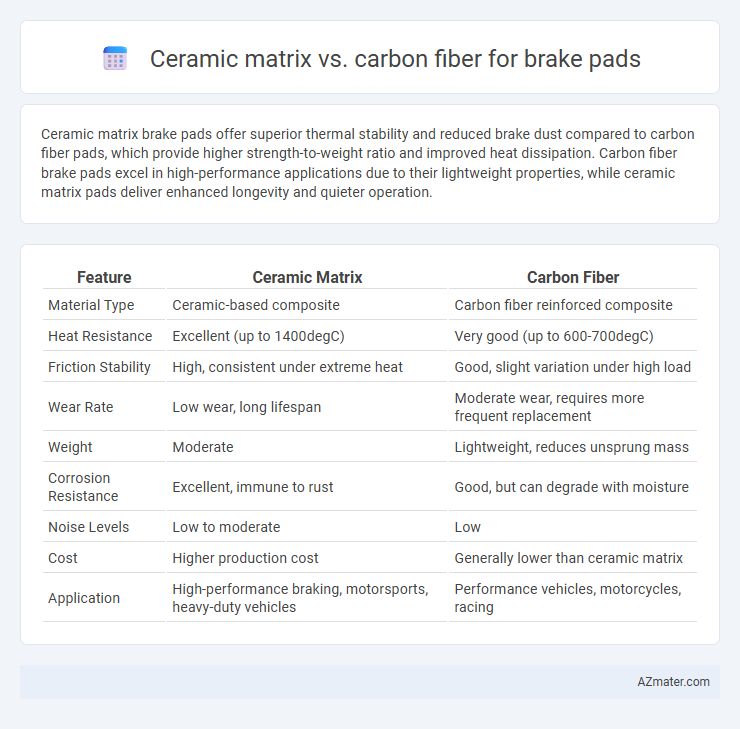Ceramic matrix brake pads offer superior thermal stability and reduced brake dust compared to carbon fiber pads, which provide higher strength-to-weight ratio and improved heat dissipation. Carbon fiber brake pads excel in high-performance applications due to their lightweight properties, while ceramic matrix pads deliver enhanced longevity and quieter operation.
Table of Comparison
| Feature | Ceramic Matrix | Carbon Fiber |
|---|---|---|
| Material Type | Ceramic-based composite | Carbon fiber reinforced composite |
| Heat Resistance | Excellent (up to 1400degC) | Very good (up to 600-700degC) |
| Friction Stability | High, consistent under extreme heat | Good, slight variation under high load |
| Wear Rate | Low wear, long lifespan | Moderate wear, requires more frequent replacement |
| Weight | Moderate | Lightweight, reduces unsprung mass |
| Corrosion Resistance | Excellent, immune to rust | Good, but can degrade with moisture |
| Noise Levels | Low to moderate | Low |
| Cost | Higher production cost | Generally lower than ceramic matrix |
| Application | High-performance braking, motorsports, heavy-duty vehicles | Performance vehicles, motorcycles, racing |
Introduction to Advanced Brake Pad Materials
Ceramic matrix brake pads offer superior heat resistance and reduced brake dust compared to traditional materials, providing longer wear life and enhanced performance in high-temperature conditions. Carbon fiber brake pads, known for their exceptional strength-to-weight ratio and thermal conductivity, deliver rapid heat dissipation and improved braking responsiveness in high-performance vehicles. These advanced brake pad materials significantly increase safety, durability, and overall braking efficiency in demanding automotive applications.
Ceramic Matrix Brake Pads: Key Features
Ceramic matrix brake pads feature a composition of ceramic fibers, nonferrous filler materials, and bonding agents, delivering excellent heat resistance and low noise during braking. These pads exhibit superior wear characteristics, producing less brake dust compared to carbon fiber counterparts, which enhances wheel cleanliness and durability. Their stable friction performance under varied temperature conditions makes them ideal for everyday driving with reliable stopping power and minimal rotor wear.
Carbon Fiber Brake Pads: Overview and Properties
Carbon fiber brake pads offer exceptional heat resistance and superior performance under high-stress conditions compared to ceramic matrix pads. They provide enhanced friction stability, reduced fade during repeated braking, and excellent durability, making them ideal for high-performance and racing vehicles. Carbon fiber's lightweight nature also contributes to improved vehicle handling and reduced unsprung mass.
Performance Comparison: Stopping Power
Ceramic matrix brake pads deliver consistent stopping power with excellent heat dissipation, minimizing brake fade during prolonged use. Carbon fiber brake pads provide superior initial bite and exceptional performance at high temperatures, ideal for aggressive driving and racing conditions. While ceramic pads offer quiet operation and longer lifespan, carbon fiber excels in extreme braking scenarios due to its lightweight and high thermal conductivity.
Durability and Lifespan Analysis
Ceramic matrix brake pads offer superior durability with high resistance to wear and thermal degradation, maintaining performance under extreme temperatures and harsh conditions. Carbon fiber brake pads provide excellent heat dissipation and lightweight properties but typically have a shorter lifespan due to higher wear rates and sensitivity to moisture. Overall, ceramic matrix pads are preferred for longer lifespan and consistent durability in everyday and high-performance braking applications.
Heat Resistance and Thermal Management
Ceramic matrix brake pads exhibit superior heat resistance with operating temperatures often exceeding 1200degF, maintaining performance without significant fade during prolonged braking. Carbon fiber brake pads excel in thermal management by rapidly dissipating heat due to their high thermal conductivity and low thermal expansion, reducing the risk of brake fade under extreme conditions. Both materials offer distinct advantages for heat tolerance: ceramic pads provide consistent thermal stability, while carbon fiber pads optimize heat dispersion for enhanced braking efficiency.
Noise, Dust, and Comfort Considerations
Ceramic matrix brake pads generate minimal noise and produce fine, light-colored dust that is less abrasive on wheels, enhancing comfort through smooth braking performance. Carbon fiber brake pads, while offering excellent heat resistance and stopping power, often produce louder noises and darker, more abrasive dust that can affect wheel cleanliness and driving comfort. Choosing ceramic matrix pads improves overall ride quality by reducing brake squeal and minimizing brake dust accumulation, making them preferable for daily driving conditions.
Cost Effectiveness and Market Availability
Ceramic matrix brake pads offer moderate cost efficiency with widespread market availability, making them a popular choice for daily passenger vehicles. Carbon fiber brake pads, though significantly more expensive, provide superior performance and durability but are primarily found in high-performance and racing applications. Market demand favors ceramic matrix materials due to their balanced cost-effectiveness and accessibility across automotive segments.
Application Suitability: Road vs. Track Use
Ceramic matrix brake pads excel in road applications due to their low noise, minimal dust production, and excellent heat dissipation under moderate stress, enhancing daily driving comfort and longevity. Carbon fiber brake pads are engineered for track use where extreme heat resistance, rapid fade recovery, and superior friction at high temperatures are critical for performance and safety under intense braking conditions. Selecting ceramic matrix pads for road use and carbon fiber composites for track environments optimizes braking efficiency tailored to specific driving demands.
Final Verdict: Choosing the Right Brake Pad
Ceramic matrix brake pads offer superior noise reduction and longer lifespan with stable performance across a wide temperature range, making them ideal for daily driving and light performance use. Carbon fiber brake pads provide exceptional heat dissipation and greater stopping power under extreme conditions, favored in high-performance and racing applications where aggressive braking is frequent. Selecting the right brake pad depends on driving style and vehicle requirements: ceramic for quiet, durable everyday use, and carbon fiber for maximum performance and heat resistance.

Infographic: Ceramic matrix vs Carbon fiber for Brake pad
 azmater.com
azmater.com